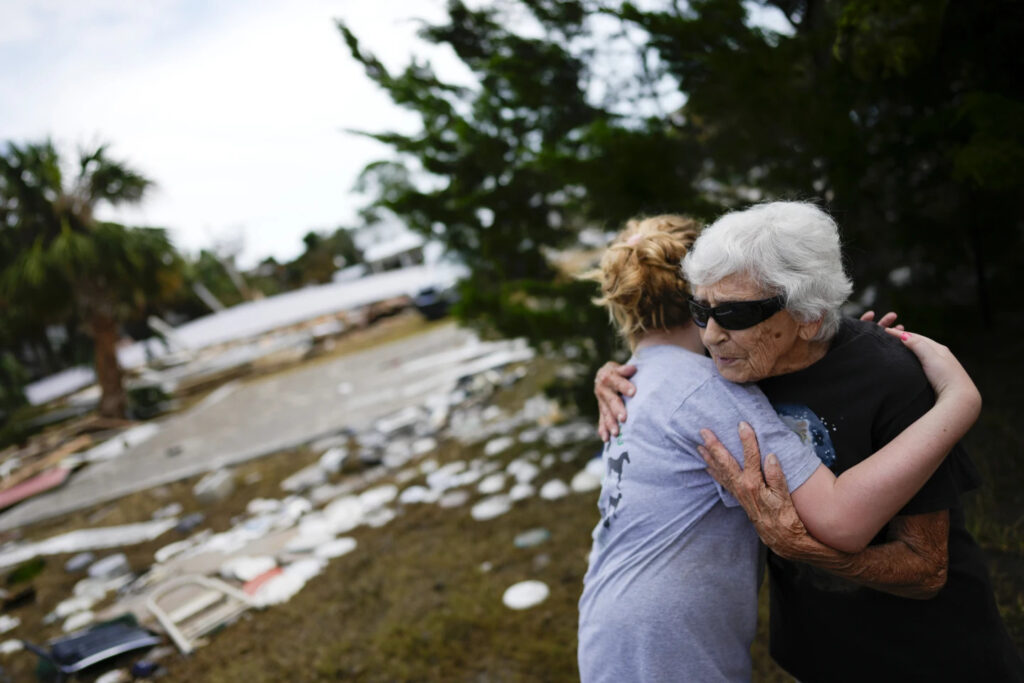HORSESHOE BEACH, Fla. (AP) — This remote seaside enclave known as “Florida’s Last Frontier” took much of the pounding from Hurricane Idalia when it struck the state’s west coast as a Category 3 storm last week.
The damage left behind in the fishing village of Horseshoe Beach is exposing a gulf between haves and have-nots as cash-strapped residents could be forced to leave the quaint, remote community rivaled by few others along the Florida shoreline.
With emergency crews still working to restore electricity and provide temporary housing, locals worry that those unable to afford insurance will struggle to reconstruct homes that must comply with modern, more expensive building codes. Longtime residents share varying degrees of bullishness that the charm — and business — will return to the quiet town of less than 200 people.
“We have all of old Florida here,” said Tammy Bryan, the song director of First Baptist Church, “and today we feel like it’s been taken away.”
Horseshoe Beach largely escaped the worst of previous storms that battered the state, but Idalia roared ashore with winds of 125 mph (200 kph) and a storm surge that flattened some houses and knocked others off their foundations and into canals.
Most residents cannot afford insurance, according to Jimmy Butler, a realtor who has been doing business in the town since 2000. He predicted that the debris may be cleared in a couple of months but a return to normal will take years.
Idalia is “the worst thing” Horseshoe Beach has ever had to handle, Butler said.
Tina Brotherton, 88, worries that the hurricane will accelerate changes that began with 1993’s so-called Storm of the Century, an unnamed, out-of-season March hurricane that pummeled the Florida Panhandle. A resident of Horseshoe Beach since 1978, she lost her marina and the cafe next door in that disaster and had to replace the floors and beds at Tina’s Dockside Inn.
Now the hotel, which she has owned for 52 years, is destroyed in Idalia’s wake. So is her home. She had no flood insurance, because her low-lying buildings made it too expensive.
Modern building codes require that houses be elevated to certain heights to protect against storms, and lifting a house can cost tens of thousands of dollars. Brotherton said that brought “a different type of people” with “more money” and pricier homes.
“It’s not a fishing village anymore,” she said as she searched the wreckage for a stool that belonged to her mother. “We’re loaded up with golf carts and ATVs and airboats.”
Brotherton does not intend to leave the community and plans to remain close by, living with her son about 5 miles (8 kilometers) inland.
Tourism in Horseshoe Beach is fueled by the more adventurous type of visitors, drawn by its natural beauty rather than the massive, commercial developments found in many other tropical destinations. Fishing charters and shrimpers are an economic engine, and many residents are working-class people living in modest trailers or retirees in tranquil homes.
Stephanie Foley, a 41-year-old teacher whose husband and brother hope to take over her father’s crabbing business, described Horseshoe Beach as a closely knit community where folks don’t feel they have to lock their doors.
“I feel extremely safe down here, and we live right, to many, in paradise,” Foley said. “We wake up — we can go fishing any time we want.”
But she too fears that the traits that make the place special could vanish, with rebuilding prohibitively expensive for many.
“Slowly the laws regarding all of that have made it difficult to make our living on the water,” Foley said. “I think a way of life that’s treasured is going to be lost.”
Brent Woodard, the 34-year-old owner of Reel Native Fishing Charters in Horseshoe Beach, said locals figured it was only a matter of time before the area took a hit — hurricanes can only be avoided for so long in Florida.
Now his biggest concern is ensuring that the fishing industry can quickly get back to business. Storms can damage the flats where fishers and crabbers make their living, ripping up the grass where fish hide, feed and spawn.
Most locals live paycheck to paycheck, Woodard said, he wonders how many lots will pop up for sale.
Fishing “pays the bills,” he said, but, “Let’s be honest, you’re not going to become a millionaire going out and blue crabbing. You’re not going to become a millionaire going out and getting oysters or being a fishing guide.”
“They’re hard-working people,” said Jimmy Patronis, Florida’s chief financial officer. “Mother Nature’s going to wipe them off the map and they’re going to say, ‘You know what? Maybe this is a sign for us to cash out.’”
Timmy Futch, 63, who owns the Florida Cracker Shrimp & Bait Co. with his wife, had never before experienced a hurricane more powerful than a low-level Category 1. But he said he has noticed that storms have been growing “bigger” and “meaner.”
While Idalia pumped 3 feet (nearly 1 meter) of water into their shop, the structure remains sound. Thankfully the couple installed electrical sockets about waist-high in anticipation of possible flooding. They will have to repaint and replumb the place, however.
The docks were destroyed, but he saved his two boats by moving them about 85 miles (140 kilometers) away before the storm’s arrival, driving 14 hours one-way while towing a friend’s boat as well.
A fourth-generation resident and longtime shrimper, boat captain and owner, Futch hopes to reopen their business within a month and is confident the tourists will return.
“When them fish get to biting, it don’t matter what happened, six months or eight months down the road,” he said. “They’re going to come catch them some fish.”
“We’re born Floridians, and this is just kind of like a snowstorm for somebody up north. We just hunker down,” Futch said. “I guess we’re too hard-headed to quit.”
Source : apnews

